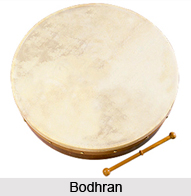 The Bodhran is a very old and rather simple instrument belonging to the family of frame drums. It is a percussion instrument which was developed and is widely used in Ireland. The Irish word `Bodhar` means deaf or haunting.
The Bodhran is a very old and rather simple instrument belonging to the family of frame drums. It is a percussion instrument which was developed and is widely used in Ireland. The Irish word `Bodhar` means deaf or haunting.
History of Bodhran
As per the opinion of musician Ronan Nolan (former editor of Irish Music magazine), bodhran evolved in the mid-20th century from the tambourine. It is also believed that the Bodhran began as a skin tray used for drawing turf (peat) on the bogs. It is also said that the Bodhran was initially used as a war drum for the Irish forces. Also, it was used to provide cadence for the pipers and warriors to keep to, as well as to announce the arrival of the army.
Design of Bodhran
It is an 18" one sided drum made from Goatskin treated by a traditional process. It consists of one or two membranes stretched over a frame. In the bodhran, the membrane is stretched over a thin, shallow, circular frame, which means that the sound has little resonance. The bodhran is struck with a small double-headed drumstick known as a mallet. The sides of the drum are 9 to 20 cm (31/2" to 8") deep. A goatskin head is tacked to one side (synthetic heads, or other animal skins are sometimes used). The other side is open ended for one hand to be placed against the inside of the drum head to control the pitch and timbre. One or two crossbars, sometimes removable, may be inside the frame, but this is increasingly rare on modern instruments. Some professional modern bodhrans integrate mechanical systems similar to those used on drums found in drum kits. It is usually with an Allen wrench that the bodhran skins are tightened or loosened depending on the atmospheric conditions.
Playing of Bodhran
Bodhran is usually played in a seated position. In order to be played, the Bodhran has to be placed on the left knee, with the head of the instrument resting parallel to the player`s leg. The shell needs to be tucked under the arm so that the drum can be squeezed against the body. The left hand is placed against the back of the head just inside the shell to help steady the drum. The Bodhran can be struck on the head or on the rim, producing a variety of sounds.
However, there are numerous playing styles. The most common is Kerry style which uses a two-headed tipper. Later, various sophisticated pitch-varying techniques which allow players to follow the tune being played were developed by artists like Tommy Hayes, Abe Doron, and Damien Quinn to name a few. These techniques gave birth to a new playing style called "top-end" style. The interesting part about bodhrán is that when it is played as an accompaniment to Irish music, different beats may be used.
Popularity of Bodhran
The bodhran gained popularity as a musical instrument in Irish Traditional Resurgence movement in the 1960`s. The bodhran is also used in modern Irish popular music. The Bodhran has also gained popularity in throughout the Celtic music world, especially in Scotland, Cape Breton, North mainland Nova Scotia and Newfoundland. The percussion instrument has also found application within the Celtic music of Spain; often accompanying the gaita gallega.




















